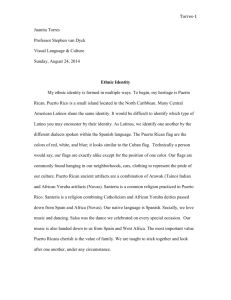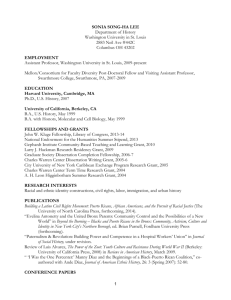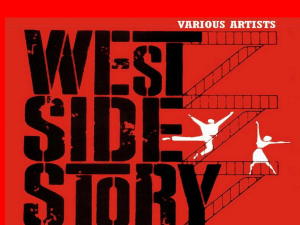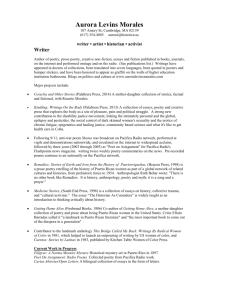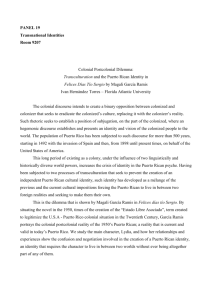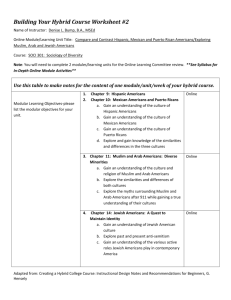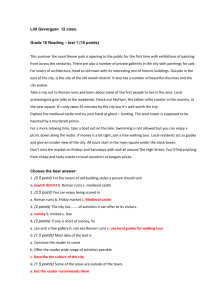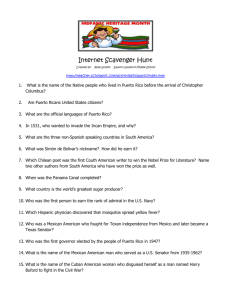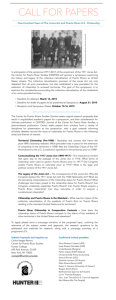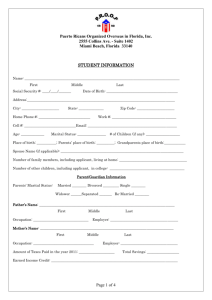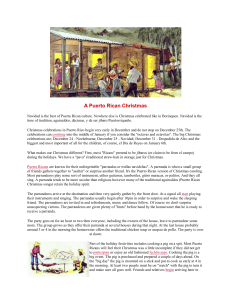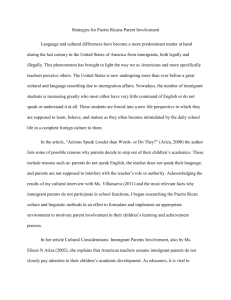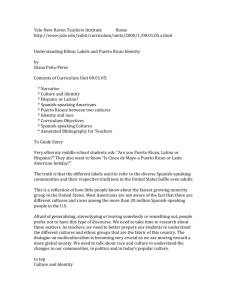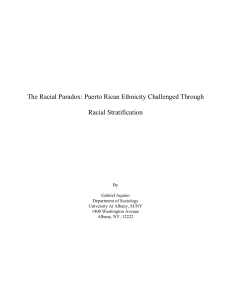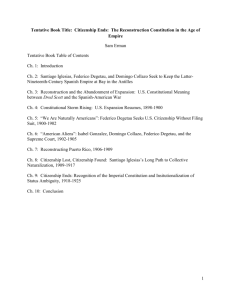File - Johanna`s e
advertisement
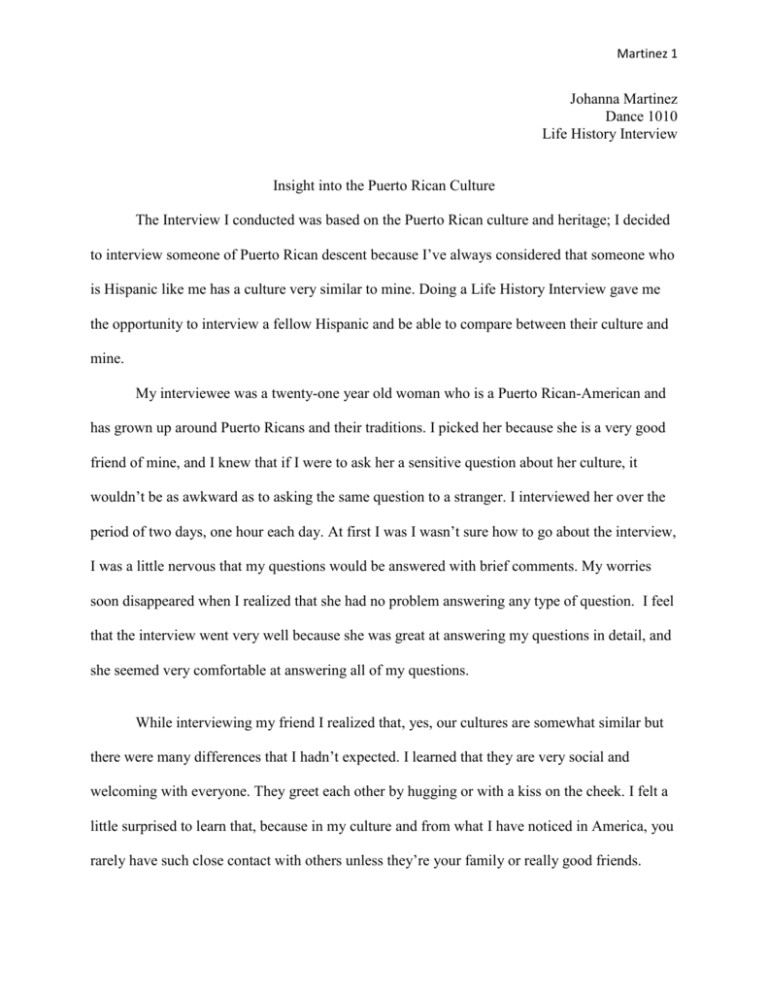
Martinez 1 Johanna Martinez Dance 1010 Life History Interview Insight into the Puerto Rican Culture The Interview I conducted was based on the Puerto Rican culture and heritage; I decided to interview someone of Puerto Rican descent because I’ve always considered that someone who is Hispanic like me has a culture very similar to mine. Doing a Life History Interview gave me the opportunity to interview a fellow Hispanic and be able to compare between their culture and mine. My interviewee was a twenty-one year old woman who is a Puerto Rican-American and has grown up around Puerto Ricans and their traditions. I picked her because she is a very good friend of mine, and I knew that if I were to ask her a sensitive question about her culture, it wouldn’t be as awkward as to asking the same question to a stranger. I interviewed her over the period of two days, one hour each day. At first I was I wasn’t sure how to go about the interview, I was a little nervous that my questions would be answered with brief comments. My worries soon disappeared when I realized that she had no problem answering any type of question. I feel that the interview went very well because she was great at answering my questions in detail, and she seemed very comfortable at answering all of my questions. While interviewing my friend I realized that, yes, our cultures are somewhat similar but there were many differences that I hadn’t expected. I learned that they are very social and welcoming with everyone. They greet each other by hugging or with a kiss on the cheek. I felt a little surprised to learn that, because in my culture and from what I have noticed in America, you rarely have such close contact with others unless they’re your family or really good friends. Martinez 2 When I asked if her culture had been influenced by interacting with the privileged American culture, she replied that she felt very much influenced by it because since she grew up here in the United States, she has always had to keep her Puerto Rican culture intact but also learned to combine it with the American way of living. For example, when she talks to Puerto Rican people, she knows that a hug won’t seem over friendly, as it usually is seen to Americans. She also expressed to me the need to know Spanish very well but also be able to speak English fluently, since she’s always interacting in both languages. When she explained this to me, I understood her completely, because I myself do that every day. I personally think that when you grow up around two cultures, sometimes they might clash a little but variety makes life interesting. When it comes to the attitudes and expectations of individuals at different stages in life, I learned that we have the same attitudes and expectations. She explained to me that children are treated with love and taught to be respectful towards others; teenagers are expected to graduate and become respectful people and find something in life they are passionate about. The elder stage is the most valued, because individuals in that stage are considered full of wisdom and should be respected and loved unconditionally. I myself feel exactly same way. She also explained that in her culture, hardly anyone would ever consider putting their parents or grandparents in a “home” as is usually done here in America. To her that’s disrespectful, because it’s like trying to get rid of them, when they should be highly respected because they are the people who have taken care of us and helped us become who we are. In the Puerto Rican culture, my friend described that when speaking to someone they always try to use a positive tone, even when they’re angry, because it helps them get their point Martinez 3 across without saying something they might later regret. Puerto Ricans also use a lot of hand gestures when talking, and standing too close to someone is inappropriate, especially when they are the opposite sex. Eye contact while talking is very important also because eye avoidance makes you seem untrustworthy or as if you’re hiding something. When it came to food, I learned that Puerto Ricans eat a lot of bananas and mixing them with meat isn’t something unusual. They also prefer sweet things compare to spicy things, it was interesting to learn this, because in my culture we usually never mix bananas with anything and our meals are typically very spicy. I didn’t let my interviewee know this because I wasn’t sure if it would make her feel uncomfortable. Furthermore, I learned that they eat a lot of seafood, and that sweet potato, and chicken with rice, is very typical. When it comes to relationships between food and health, Puerto Ricans eat a lot of cod fish with salad for overall health, and take a lot of fish oil for skin and brain health. Herbs aren’t really used for medical reasons, but different types of teas are used for congestion and colds. As for foods that are taboo, I learned that there aren’t really any, but the tongue and brain of an animal are rarely ever eaten. I was somewhat surprised to find that out, because to me it’s nothing out of the ordinary. When I asked her about table manners or customs, she stated that in her family they do say grace before eating, but that she wouldn’t call it something that is traditional in Puerto Rican culture. She also told me that most of the table manners that they follow are common sense, such as having clean hands at the table, keeping elbows off the table, not letting food hit the table top or the floor, not “clinking” utensils against plates or bowls, not slurping liquids, not talking with mouth full, and not passing arms or hands over other’s plates or cups. In addition, eating with hands is only accepted when eating sandwiches, cookies, and certain fried foods. Martinez 4 When I asked about clothing, I found out that they usually dress just like Americans would, but that they do use a lot of light colors to express their calm and to show that they are fun to be around. I thought it was interesting that they used clothes to portray their sense of calmness; I had never heard of that before. In a way, it makes sense, though, that light colors can portray a relaxed mood. My friend also told me that although they like to be seen as calm people who “take things as they come,” they do value and take family, respect, freedom, and a good education seriously, just as any American would. Puerto Ricans acknowledge all American Holidays, except Columbus Day because they feel that it doesn’t relate to them. She also stated that because she is Christian they do not celebrate Halloween, which people in America find odd. She does celebrate a holiday called “El Dia de Los Reyes” which means The Day of The Kings. It is celebrated because it is thought to be the day that the three kings brought gifts to baby Jesus, and they celebrate it by giving away baby figurines in shoe boxes, filled with grass to symbolize Jesus’ hay filled basket. When asking about the way they celebrated most holidays, I wasn’t surprised to find that music and dance are not only used to celebrate holidays, but also for family reunions, and any other big event. I did learn, though, that dance and music are used as a way to tell stories, that dance is also intended for everyone, and no dance has a religious origin unless it’s telling a biblical story. One of the most popular types of dance is the Salsa (which involves a lot of hip movement). My interviewee also felt that the main thing that has changed about her culture is music; she explained that music has changed from using simple instruments like the drums and maracas to make music, to music that is made in a studio. She feels that change can be good, but hopes that music from past generations will not be forgotten. Martinez 5 When I asked my friend about her experience here in the United States and in Utah, she explained that she grew up in Boston, Massachusetts, where there’s a lot of diversity in the population, so she never really felt segregated from the overall community. It was not uncommon in Boston to see people from many different cultures, but once she moved to Utah, she realized that the overall population here is over all very “white”. She also stated that she feels that Hispanics in Utah are all categorized as Mexicans, when in reality, not every Hispanic is from Mexico. Overall, though, she doesn’t feel that like the dominant white group has shunned or treated her badly, but it’s noticeable that Utah has not been exposed to many Puerto Ricans, or other cultures for that matter. I’ve always imagined that every Hispanic culture is very similar; doing this interview has taught me that no culture is really alike. I learned that something that seems very unusual to me, like mixing bananas with meat, is very common in Puerto Rico, and something as common to me as eating the tongue of a cow is very rare to Puerto Ricans. I always thought of Puerto Ricans as very relaxed people who don’t like to worry about things too much, I discovered, though, that just because they like to be calm doesn’t meant they don’t value the important things in life. Something I was surprised at was that my friend worried that music from past generations would be lost; I had never thought that losing a type of music could be like losing a part of your culture, but hearing it from someone else makes me realize that it’s very true. I also found it interesting that the “white” community here in Utah tend to think that most Hispanics are of Mexican descent. When, of course, that isn’t true at all. Furthermore, I discovered that keeping your culture intact and fitting in with a new culture at the same time is not only hard for me but for others too.

